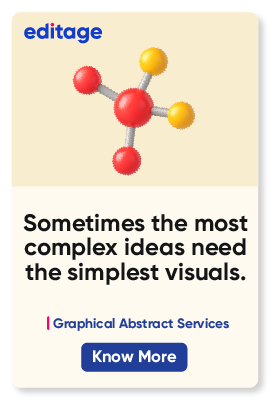Visual abstract: The extra element that can make your research paper more accessible

No matter how long you have been writing research papers for or how appealing you believe your papers are to your research peers worldwide, interesting research alone isn’t sufficient to grab the attention of your audience. To attract and hold their attention effectively, more can be done, for example through visual abstracts.
A visual abstract is a graphical way of describing what a research paper is all about. But most scholars don’t know this is a format they can use because they think the written article alone is more than enough. So, in this article, we’re going to talk about visual abstracts—what they are, what the different types are, how they help to enhance the communication of results, and what their overall impact is.
What is a visual abstract?
As technology constantly evolves and makes information easier to process, people tend to spend less time on things that don’t appeal to them. Instead, they prefer to see things that are attractive, valuable, or that provide knowledge and wisdom easily. There are new and improved ways in which you can present your work so that your content piece is concise, visually appealing, and easily comprehensible, and engages audience attention.
One such innovation is a visual abstract—a format that is becoming extremely popular among the scientific community as a powerful method of presenting research findings.
A visual abstract is a summary of a scientific publication that clearly communicates key information and conclusions by combining text, graphics, and design components. Visual abstracts are frequently used to promote research articles or to share findings with a broader audience. They are typically intended for social media platforms like Twitter or LinkedIn, which are important spaces for researchers and publishers to gain and connect with audiences.
What are the components of a visual abstract?
A visual abstract usually consists of four main elements: a title, an image, a brief summary of the research findings, and a call to action.
The title should be brief and catchy because the first impression is the best impression, while the image should be visually pleasing and should capture the central research topic. The summary should be concise and highlight the key findings of the study, and the call to action should encourage readers to engage with the original research article.
What are the types of visual abstracts?
Here are the most common types used by researchers:
1. Infographic-style abstracts: These abstracts combine different elements—text, graphics, and data visualizations, such as charts.
2. Image-based abstracts: In these abstracts, the key findings or concepts are conveyed through a single image or a collection of photos. These can be especially useful for research that includes visual components, such as microscopy or medical imaging.
3. Animated abstracts: These abstracts communicate important findings and concepts using animation or videos. These are used for research involving intricate mechanics or processes as these topics can be explained well through animated videos rather than conventional ones.
4. Interactive abstracts: These abstracts are mainly used in research that involves a lot of data. They give viewers the option to interact with the visual components, such as zooming in on particular data points or viewing various diagrams by clicking on or hovering the cursor above the visual abstract.
The type of visual abstract that you choose will ultimately depend on the subject matter of your study and the message you hope to convey through it. You can spread the word about your discoveries and boost the impact of your study by choosing the correct type of visual abstract and using it effectively.
How do visual abstracts help in boosting the reach and impact of an article?
A key advantage of visual abstracts is that they are simpler to understand than conventional abstracts. Conventional abstracts can be challenging to read for non-experts because they are sometimes written in technical language. On the other hand, visual abstracts combine text and visuals to present information in a straightforward manner. This can be especially helpful for you if you want to communicate with people outside your own field of expertise.
Moreover, visual abstracts can improve the reach of research articles. You can reach a wider audience and generate interest in your study by posting visual abstracts on social media. This may result in more citations for the study and, thus, greater impact, which is advantageous for both you and your institution.
Another benefit of visual abstracts is that they can serve as a powerful tool for scientific communication (the process of conveying scientific knowledge to non-experts). Visual abstracts can bridge the gap between scientists and the general audience through images and plain language.
How can you create a good visual abstract?
- Identify the main concepts and conclusions of your study.
- Choose a layout and color style that best complements your study subject. Remember that the visual abstract should be simple to read and aesthetically pleasing.
- Use simple and understandable icons and illustrations.
- Use graphs or charts.
- Add a title that sums up your research in a few words.
- Add a brief introduction that provides context.
- Briefly describe each idea or finding that is presented in the visual abstract by using text boxes.
- Make sure the visual abstract accurately reflects your study and is easy to grasp.
- Share your visual abstract on social media platforms and academic websites to reach a wider audience.
Despite their benefits, visual abstracts are not without their limitations. Compressing the information into a manner that is both brief and informative is one of the key problems of designing a visual abstract. This involves selecting the key details carefully and developing the visual components creatively. Moreover, visual abstracts might not be suitable for highly complex studies and are not ideal for all forms of research articles.
What impact do visual abstracts have in the digital era?
Visual abstracts have made a great impact, with increasingly more non–subject specialists now reading research published by domain experts. This has become possible because audiences can now more easily understand complex research matter through visually appealing formats along with text.
Visual abstracts tend to be more engaging than traditional text-based abstracts as they break down complex stuff into simple understandable bits using images and graphics. They help readers to understand a complex concept easily, thus increasing their reach since they can be shared on social media and are more easily accessible than traditional abstracts.
In conclusion, visual abstracts are an effective innovation in scientific communication that can assist researchers in communicating their work in an approachable and compelling way.
Looking to make your research more impactful? Check out Editage’s Graphical Abstract Design Services and get professional support to make your research stand out.










